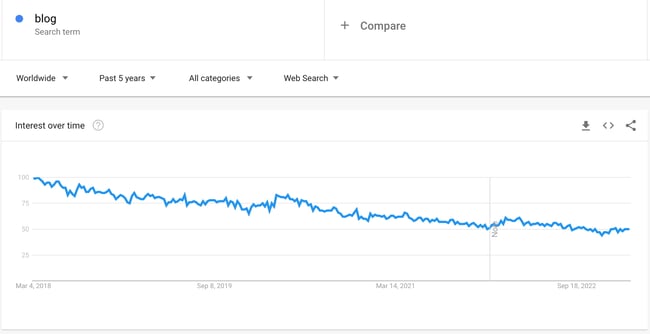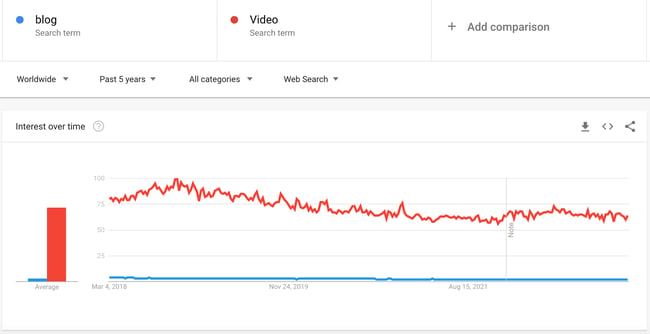With the rise of video and podcasting, one could assume that blogging is dead as an effective marketing channel.
After all, it seems we have an obsession with killing things off. In the new millennium, we had the Y2K computer scare. When technology took a more important role in our lives, we assumed all print publications would go bankrupt. Now that video content is having its time in the sun, some speculate that blogging could soon meet the same fate as the dinosaurs.
I reached out to marketers with backgrounds in product marketing, SEO, YouTube, podcasting, and more and asked them, “Are blogs dead? ” Here’s what they said.
In all fairness, this question surrounding blogs is not without reason. Google Trends shows that in the last five years, the interest in blogs has steadily declined worldwide.

In the U.S. within the same five-year span, video has risen in popularity and surpassed blogs in searches.
However, blogs are still viable marketing channels with WebTribunal reporting there are more than 600 million blogs out of 1.9 billion websites worldwide. Collectively these blogs generate 6 million posts daily with WordPress and Tumblr being the most popular platforms.
Marketers still consider blogging a top marketing channel. Ross Simmonds, a B2B marketing expert and the founder of the content marketing agency Foundation, says blogging has helped his clients triple their traffic and accelerate their sales close rates.
“At Foundation, blogging with intent has helped us generate millions of dollars in the pipeline for both us and our clients,” says Simmonds. “It’s also armed us with the ability to elevate our brand’s position in the market and, most importantly, truly help others in our industry learn and unlock new opportunities.”
With that said, the blogging landscape has changed over the years. Lisa Toner, director of content at HubSpot, says it’s not enough to just have a blog nowadays.
“You need to consistently create content that is more valuable than your competition’s content. You need to be an SEO expert to get your articles ranking on page one of Google, and you need a distribution strategy to promote your content across all the channels your audience likes to consume content on,” says Toner.
“It’s a lot more complex to win at blogging now, but if you can master it, it’s worth the investment.”
Transparency is a bigger responsibility, especially as consumers are paying closer attention to a brand’s values and its stance on social issues.
“You need to think about how people see your brand compared to your competition. Everyone has their own unique selling position (USP) and what they want to put forward, but what users do is compare,” says Sandra Mpouma, head of digital marketing at RationalFX.
“So, in terms of business strategy, create loyalty, trust, [and] be transparent and competitive, which is very important nowadays.”
Blogs vs. Other Marketing Channels
Now that other content marketing channels – namely video and podcasting – have surpassed blogs, will blogs soon become redundant?
Well, it all depends on the user personas you’re targeting. But even as other platforms grow, blogs still offer many advantages.
“Podcasting is not without its own set of limitations. There are plenty of discoverability and audience growth challenges. At this point, blogs have a pretty well-dusted playbook for scaling. That’s not true for podcasts,” says Matthew Brown, senior podcast producer at HubSpot.
“A company can use its likely limited resources to invest in a blog that will basically give consistent, easily measurable, and reliable performance. Blogs also have a direct line to the company’s bottom dollar, podcasts do not.”
Nelson Chacon, the principal content strategist for YouTube at HubSpot, highlights that there’s no reason to choose between two platforms if your team has the bandwidth to tackle both.
If it aligns with your user personas, you can engage your audience from several angles.
“Creating a blog constructed of articles around the benefits of your product will be helpful. Having a video showcasing its use or how to install it would be beneficial for your audience,” says Chacon.
He continues, “Home Depot has done a fantastic job of doing this. While they inform and educate their customers on their products, they also add a quick ‘how-to’ for the more knowledgeable person who just needs a short answer explained in a video.”
As for social media, Annabelle Nyst, a senior content strategist who focuses on social media initiatives at HubSpot, says it’s hard to compare it to blogs as each platform serves different purposes.
“Social content doesn’t always have the shelf life or the discoverability of blog posts,” says Nyst. “It’s more about consistently meeting your audience where they are, in the right moments, engaging with them one-on-one, and establishing trust via community building.”
She adds that social media can be a great way to amplify your blog posts. And vice versa, blog posts can serve as inspiration for social content.
If using both, Nyst recommends pulling the most compelling points from your blog posts, creating social-first content, and using it to drive traffic back to your blog.
With all that said, blogs don’t come without their disadvantages. AJ Beltis, a senior content and acquisition manager at HubSpot, mentions the high drop-off rates often seen in blog posts.
“Blogs lack the interactivity that many crave due to its nature as written content,” says Beltis. “This challenges blog writers to hook their readers in a few short sentences without having the benefit of special effects or audio engineers available to their video and podcast creating counterparts.”
What it often comes down to is your brand goals and which channels will help you meet them. Podcasts, for example, are better for branding while blogs serve better for top-of-the-funnel engagement.
“Blog posts are an acquisition juggernaut. There’s a clear path that any seasoned marketer can follow. Podcasts, however, best serve as a brand opportunity,” says Brown.
“You wouldn’t measure a series of blog posts on their brand uplift ability, just like you wouldn’t measure a podcast show’s lead generation. That is unless you like gray hairs and a serious lack of sleep.”
Why Blogs are Still Impactful
From an investment perspective, blogs may be a better long-term investment for lead generation.
“I could spend $200K to hire a full-time writer, SEO expert, and conversion rate optimization (CRO) specialist to work on my blog. By combining those skill sets, I’m going to be able to create a blog that drives organic traffic to my website and converts it into leads for my business all year long,” says Toner.
She continues, “Or, I could put the same $200K into an advertising campaign and maybe get a couple of thousand leads over the course of the ad campaign. But once the campaign ends, so does my lead flow.”
Toner adds that the majority of HubSpot’s blog-generated leads come from older blog posts. This means that blogging can be a great lead source long after posts are published. Aja Frost, who leads the English SEO team at HubSpot, echoes this sentiment.
“Organic traffic is more important than ever. Unlike paid traffic, which stops coming in the second your budget runs out, organic traffic is mostly self-sustaining after you’ve put in the time and effort to create a blog post,” she says.
She adds that most content management systems (CMS) have SEO tools integrated into their platforms, which makes it easier to optimize your posts.
Blogging can also be valuable in shaping a brand’s product positioning.
“Blogs are still one of the best channels we have to create narratives around our product,” says HubSpot Product Marketing Manager Alex Girard. “They offer us the opportunity to address trends we see in the market, how those trends impact the reader, and how our product might be able to help them meet that trend successfully. They’re also great for telling customer success stories.”
He adds that when using your blog to market your product, the content doesn’t have to be promotional. When you establish yourself as a thought leader and gain the trust of your audience, they will organically look into your products and services.
With that said, it’s going to take more than good content to have a successful blog.
“Growth without a goal isn’t going to help your business – if 10,000 people are reading your blog, but none of them fit your persona, that’s not going to do anything for your company,” says HubSpot’s Senior Blog Manager Karla Heseterberg. “Focus on something attainable, like generating new contacts, and make sure every post you’re putting out has that goal in mind.”
She adds that one of the biggest mistakes brands make is creating content only for people at the decision-making stage.
With so many stages between reading a blog and making a purchase, marketers should have posts geared at users in every stage with corresponding offers.
Learn more about that through HubSpot’s business blogging course.
From an SEO perspective, brands may also struggle with generating traffic because they’re thinking blog first, link building second.
“What I often notice is that marketers see ‘blogging’ and ‘link building’ as two different disciplines. First, they write the blog posts, then they think about how to earn backlinks to them,” says Irina Nica, a senior product marketing manager at HubSpot who works on product awareness through outreach initiatives.
“Instead, they should include linkable assets into their regular content calendar, alongside other types of articles that are maybe designed for generating organic or social media traffic.”
Despite the many benefits we’ve gone over, blogging isn’t always the best strategy for every brand. Why? Well, what if your ideal user persona doesn’t read blogs? What if they prefer emails instead?
“Some brands have great email communication and workflows where they provide people with downloadable offers where they don’t have to go somewhere else to get the information, it’s just in their inbox straight away,” says Mpouma.
“You don’t necessarily need a blog as long as you’re offering something in exchange. I think the blog has always been that: Offer something for free in exchange for that user interaction.”
So, in that case, blogs wouldn’t exactly be dead, more so irrelevant.
Why Marketing Isn’t Dead
Looking at things from a broader perspective, blogs are just an extension of marketing. Some have suggested that marketing is dead, which makes marketers like me wonder if there’s something we don’t know.
Based on recent data, marketing is still influential. And that applies to both traditional strategies and digital initiatives. Statista reported that in 2022, content marketing generated over $63 billion in revenue worldwide.
“There’s a reason why Nike and Mcdonald’s continue to invest millions every month in marketing even though they’re already household names. There’s a reason why the top musicians and artists still do promotion prior to their latest album release,” says Simmonds.
“Marketing isn’t to be seen as just an expense. It’s an investment. And if you make an investment that is rooted in a strategic plan — that investment should return dividends for years (maybe decades) to come.”
Blogging Is Far From Dead
The key takeaway is that while not all marketing tactics work for every brand, it’s unlikely that blogs will stop being valuable to brands in the foreseeable future. S
o for now, blogs, you can rest and step off the chopping block.
Editor’s note: This article was originally published in February 2021 and has been updated for comprehensiveness. 



